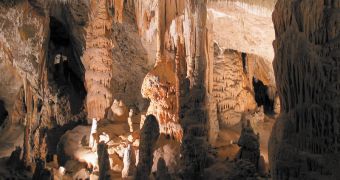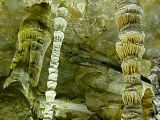What is more amazing about a cave landscape than the presence of stalactites and stalagmites? A stalactite ("drip" or "that which drips" in Old Greek), also called dripstone, is a type of speleothem (secondary mineral) hanging from the ceiling or wall of limestone caves. The wonderful sharpened cones are the result of the chemical reaction between water and limestone. Its floor corresponding concretion is called stalagmite. Sometimes, stalactites and stalagmites can meet, forming columns.
The carbon dioxide dissolved in the rain water droplets and attacks the limestone rock, which is made mostly of calcium carbonate (CaCO3) or calcite. As a product of this reaction, the newly formed chemical is (Ca(HCO3)2), also called calcium hydrogen carbonate, an extremely water soluble compound.
While on the roof of the caves bicarbonate filled water is filtered, the carbon dioxide is released, and the resulting calcium carbonate precipitates. The newly precipitated calcium carbonate starts forming concretions around the falling point of the droplets towards the cave's floor. A stalactite starts with a tiny ring of calcite deposited by the falling water droplets. In time, the deposits build a very narrow (0.5 mm), hollow tube called "soda straw" stalactite, which can be very long, but easy to break. Further calcite deposits left by water build the typical cone-shaped stalactite.
This is an extremely slow process, as a stalactite requires millions of years to form. It is estimated that the growth rhythm of the stalactites is about 2.5 cm (1 in) in 4,000-5,000 years.
The same droplet that leaves behind the stalactite deposits calcite on the floor below, creating the stalagmites. Stalagmites do not begin as hollow "soda straws". World's largest stalactites are considered those encountered in the Chamber of Rarities in the Gruta Rei do Mato (Sete Lagoas, Minas Gerais, Brazil): 20 m (66 ft) long.

 14 DAY TRIAL //
14 DAY TRIAL // 
